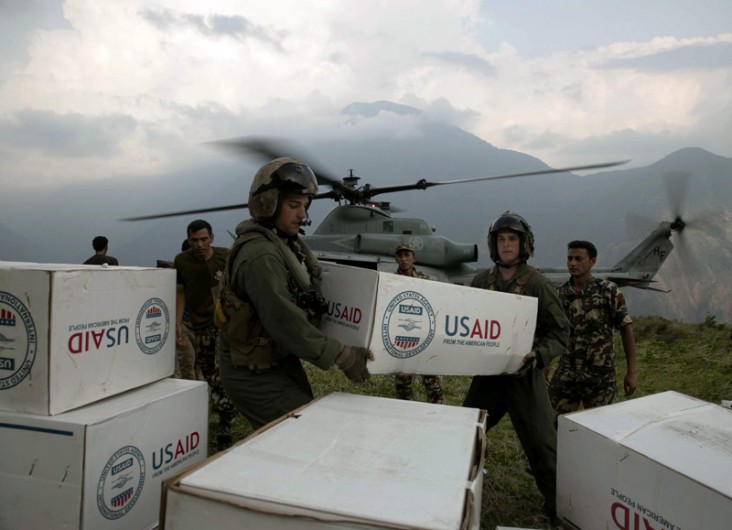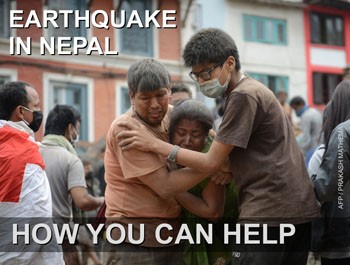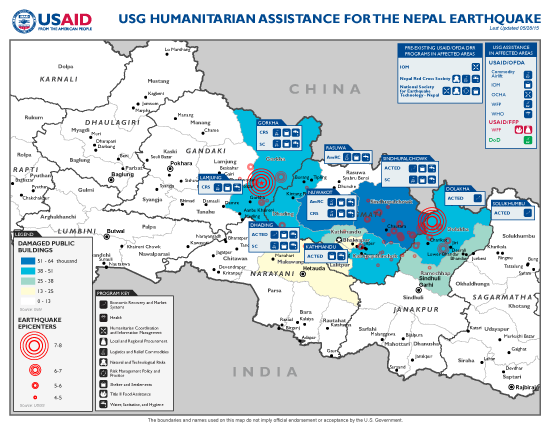Speeches Shim
May 28, 2015
Highlights
Meteorologists forecast that monsoon rains will begin in Nepal in early June.
With USAID/FFP support, the UN World Food Program (WFP) reaches more than 1.8 million earthquake-affected people with food assistance.
USAID/OFDA commits $500,000 to the UN World Health Organization (WHO) to support health interventions.
Key Developments
Ongoing aftershocks, landslides, and pre-monsoon rains continue to hinder relief and reconstruction operations in areas affected by the April 25 earthquake. Furthermore, relief agencies expect the impending monsoon season to negatively impact the delivery of humanitarian assistance and community access to available services, as roads become muddy and difficult to navigate, landslides block bridges and footpaths, and rain and fog prevent air transport.
Nepal Earthquake Map - May 28, 2015 ![]() (pdf - 967k)
(pdf - 967k)
Numbers At A Glance
2.8 million
8,670
773,174
501,783
271,391
Humanitarian Funding:
To Nepal To Date In FY2015:
| USAID/OFDA | $34,000,000 |
| USAID/FFP | $6,900,000 |
| DoD | $21,146,289 |
| TOTAL | $62,046,289 |
Nepal Earthquake Map - May 28, 2015 ![]() (pdf - 967k)
(pdf - 967k)
The India Meteorological Department forecasts that the 2015 monsoon rains will begin in southeastern Nepal during the first week of June and reach western parts of the country by June 20. On average, the monsoon season lasts for 105 days in Nepal and brings 80 percent of the country’s annual rainfall. The GoN and relief agencies continue efforts to reach earthquake-affected populations in advance of the monsoon, which will likely intensify humanitarian needs while also hampering access to populations in need.
On May 27, the U.S. Geological Survey (USGS) released an updated aftershock advisory for Nepal, reporting that zero-to-five earthquakes with a magnitude between 5.0 and 6.0 will likely occur in the coming month; the chance of at least one aftershock occurring within that range is approximately 62 percent. There is a 1-in-10 chance of a magnitude 6.0-to-7.0 aftershock occurring and a 1-in-100 chance of a magnitude 7.0 –to-7.8 aftershock occurring. Although unlikely, an aftershock larger than the initial magnitude 7.8 earthquake remains a possibility.
Many communities in rural areas of Nepal remain nervous about additional earthquakes and are requesting information on how and when they will occur, according to relief agencies. The Communicating with Communities Working Group reports that communities need additional information regarding disaster preparedness as well as information explaining response and recovery activities and services.
HUMANITARIAN ASSESSMENTS
On May 24 and 25, staff from the USAID Disaster Assistance Response Team (DART), including USAID/OFDA shelter and settlements and water, sanitation, and hygiene (WASH) advisors, conducted field visits in multiple village development committees (VDCs) in Sindhupalchowk and reported that providing emergency shelter and sanitation assistance remain the primary humanitarian priorities in earthquake-affected areas.
Relief agencies working in Sindhupalchowk—currently approximately 350—anticipate reaching nearly all targeted households in the district with emergency shelter kits before the monsoon arrives; however, complete emergency sanitation coverage will require additional time. As a result, the sanitation strategy has shifted from providing one toilet per household to providing one toilet for every three-to-four households until after monsoon season.
Many local markets in Sindhupalchowk were severely damaged by the May 12 aftershock, and market assessments have identified a limited supply of construction materials, indicating that local markets will be unable to support full cash- or voucher-driven shelter and sanitation activities, according to the USAID/OFDA advisors. As a result, relief agencies plan to use cash or vouchers to complement in-kind distributions of shelter and WASH commodities.
DART staff also conducted aerial assessments of northern parts of Gorkha District on May 24 and confirmed significant earthquake and landslide damage in the majority of observed villages. Although the international community has reported that most of northern Gorkha is inaccessible by road, the team noted that a number of villages appeared to have plastic sheeting, potentially carried in on foot.
SHELTER
During the visit to VDCs in Sindhupalchowk, the USAID/OFDA shelter and settlements advisor observed that many households have salvaged materials from collapsed houses and are constructing robust temporary shelters that incorporate tarpaulins and shelter kits to strengthen and waterproof the structures. The advisor noted that the shelters constructed by local communities are more substantial than any shelter the humanitarian community could have delivered within one month of the earthquake through a supply-driven approach. Based on these observations, the advisor identified the continued distribution of plastic sheeting and supplementary shelter supplies, such as rope and nails, as the most appropriate shelter response activity prior to monsoon season.
As of May 27, the Agency for Technical Cooperation and Development (ACTED) had distributed all 350 rolls of USAID/OFDA-supplied plastic sheeting received from the International Organization for Migration (IOM) to vulnerable households in Dhading and Sindhupalchowk districts. ACTED distributed a total of 150 rolls of plastic sheeting to Gumdi, Katunje, Marpak, and Semjong VDCs in Dhading and 200 rolls to Mankha VDC in Sindhupalchowk.

HEALTH
According to WHO, the April 25 earthquake and aftershocks have damaged or destroyed more than 1,000 health facilities in Nepal, hindering the provision of primary health care services in many earthquake-affected areas. Additionally, overcrowding in displacement sites and disruptions to WASH systems have resulted in an increased risk of communicable diseases, including diarrhea, respiratory infections, and mosquito-borne illnesses—a particular concern during the impending monsoon season.
Since April 25, more than 140 foreign medical teams (FMTs) have deployed to Nepal to work in the most-affected districts; 42 FMTs teams comprising more than 260 doctors and nearly 240 nurses remained in country as of May 26, according to WHO. More than 130 relief agencies in the Health Cluster—the coordinating body for humanitarian health activities, comprising UN agencies, non-governmental organizations, and other stakeholders—are also collaborating with the GoN Ministry of Health and Population (MoHP) to provide health care services in hard-to-reach areas that have not yet received medical assistance.
As of May 28, the GoN Ministry of Home Affairs (MoHA) reported more than 21,000 injured persons as a result of the April 25 earthquake and aftershocks; however, the GoN Health Emergency Operations Center (HEOC) reported 3 providing treatment to nearly 103,700 earthquake-affected people as of May 15. The HEOC total includes patients who received psychosocial support, which may partly explain the discrepancy in figures. Additionally, the MoHA and HEOC have not clarified the types of injuries being included in their reporting figures.
On May 26, USAID/OFDA provided $500,000 to support WHO’s health interventions in Nepal. With USAID/OFDA support, WHO is working to strengthening Nepal’s disease surveillance system to prevent communicable disease outbreaks. WHO is also providing essential health services to affected populations, supporting MoHP coordination at the district level, and establishing water and sanitation facilities at health facilities.
FOOD SECURITY AND AGRICULTURE
The GoN Ministry of Agriculture and Development (MoAD) has requested that humanitarian agencies include ghee in emergency food baskets, as ghee is a culturally accepted food in Nepal, can be stored for up to six months, and distribution will help the rural economy. The dairy supply in Nepal has increased by approximately 30 percent, but demand has reduced significantly, according to the MoAD. If the situation continues, then Dairy Development Committee (DDC)—a state owned corporation initiated for the economic advancement of poor farming communities in Nepal—may need to cease purchase of milk products for distribution in urban areas, which will have a large economic impact on farmers. However, if relief agencies include ghee in food baskets, the DDC can supply 100 metric tons (MT) within 10 days at a subsidized rate, according to MoAD. The Food Security Cluster has requested a formal request letter from MoAD outlining technical specifications.
WFP is currently revising its emergency operation strategy to incorporate findings from the latest Food Security Cluster assessment and align WFP activities with the GoN response plan. The revised strategy will likely extend operations through the end of December and be implemented in three phases, WFP reports.
USAID/FFP is providing $6.9 million in support of WFP’s emergency food assistance operations in Nepal, including approximately $4.4 million of in-kind emergency food assistance from its warehouse in Colombo, Sri Lanka, and $2.5 million for the local procurement of rice. As of May 25, WFP reported reaching more than 1.8 million people through general food distributions in seven of the most-affected districts, including Dhading, Dolakha, Kavre, Gorkha, Nuwakot, Rasuwa, and Sindhupalchowk .
INTERNATIONAL ASSISTANCE
To date, the USG has provided more than $62 million for earthquake response and recovery efforts in Nepal, while other international donors have provided more than $249 million. Of the total international assistance, approximately $100 million has supported the current flash appeal—24 percent of the $423 million requested. The Humanitarian Country Team plans to release a revised appeal in the coming days.
CONTEXT
On April 25, a magnitude 7.8 earthquake struck central Nepal’s Gorkha District, approximately 77 kilometers (km) northwest of Kathmandu, at a depth of approximately 15 km, according to the U.S. Geological Survey (USGS).
The USG immediately issued a disaster declaration for Nepal due to the effects of the earthquake. Within hours of the seismic event, USAID/OFDA activated a Response Management Team (RMT) in Washington, D.C., and deployed a DART—including urban search-and-rescue specialists—to support emergency response efforts in Nepal.
On May 12, a magnitude 7.3 aftershock struck Nepal’s Dolakha District, approximately 76 km northeast of Kathmandu, according to USGS. The aftershock caused further casualties and damages in areas affected by the April 25 earthquake.
For nearly two decades, USAID/OFDA has supported disaster risk reduction (DRR) efforts in Nepal, including throughout Kathmandu Valley. USAID/OFDA funding has enabled partners to identify, prepare, and preserve more than 80 open spaces in Kathmandu Valley for humanitarian purposes; pre-position critical emergency relief supplies; and strengthen earthquake response capacity at the local and national levels in collaboration with the GoN, non-governmental organizations, private companies, and local communities. More information on USAID/OFDA’s DRR programs in Nepal and throughout South Asia is available at www.usaid.gov/what-we-do/working-crises-and-conflict/disaster-risk-reduc....
PUBLIC DONATION INFORMATION
The most effective way people can assist relief efforts is by making cash contributions to humanitarian organizations that are conducting relief operations. A list of humanitarian organizations that are accepting cash donations for disaster responses around the world can be found at www.interaction.org.
USAID encourages cash donations because they allow aid professionals to procure the exact items needed (often in the affected region); reduce the burden on scarce resources (such as transportation routes, staff time, and warehouse space); can be transferred very quickly and without transportation costs; support the economy of the disaster-stricken region; and ensure culturally, dietary, and environmentally appropriate assistance.
More information can be found at:
- The Center for International Disaster Information: www.cidi.org or +1.202.821.1999.
-
Information on relief activities of the humanitarian community can be found at www.reliefweb.int.



Comment
Make a general inquiry or suggest an improvement.